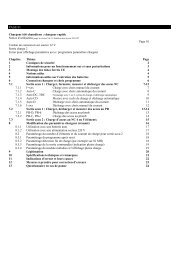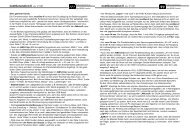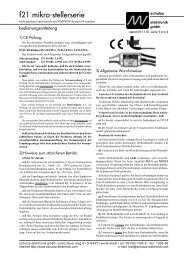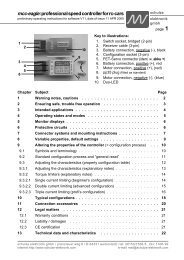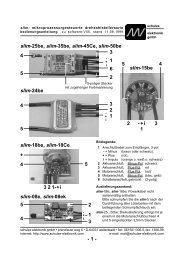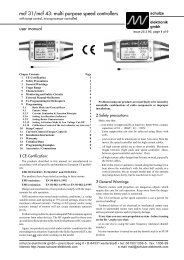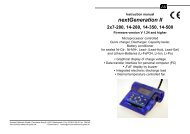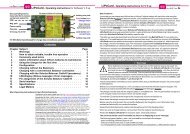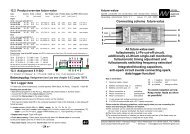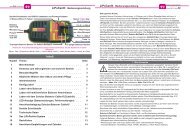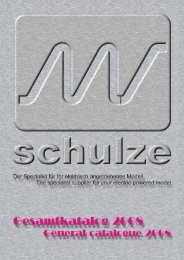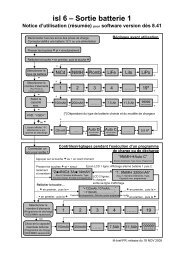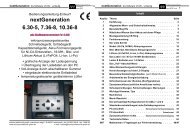ecolader: rapid discharger/charger series - Schulze Elektronik GmbH
ecolader: rapid discharger/charger series - Schulze Elektronik GmbH
ecolader: rapid discharger/charger series - Schulze Elektronik GmbH
Create successful ePaper yourself
Turn your PDF publications into a flip-book with our unique Google optimized e-Paper software.
Page 2 <strong>ecolader</strong>: <strong>rapid</strong> <strong>dis<strong>charger</strong></strong>/<strong>charger</strong> <strong>series</strong><br />
1 Warnings<br />
Injury hazard! Watch out for sharp corners<br />
and edges when handling the <strong>charger</strong> (heatsink).<br />
The CE symbol is not an excuse to handle the<br />
<strong>charger</strong>, the power supply or the batteries<br />
connected to it carelessly.<br />
Before you connect the unit to a 12 V car battery:<br />
switch off the vehicle's engine. The<br />
<strong>charger</strong> is only approved for use with a stationary<br />
vehicle whose engine is stopped.<br />
The unit must only be operated with the original,<br />
unmodified connecting cables.<br />
Avoid short-circuits between the charge outputs<br />
and the car bodywork. To be on the safe<br />
side, place the <strong>charger</strong> on the ground.<br />
The charge cables and charge outputs must<br />
never be connected to each other or shorted<br />
in any way; the result would inevitably be<br />
damage to the unit and/or the battery. To<br />
avoid short-circuits between the banana<br />
plugs on the charge cable, always connect<br />
the charge cable to the <strong>charger</strong> first, and<br />
only then connect the battery. Keep to the<br />
reverse order when disconnecting. Our<br />
safety charge cables eliminate the hazard of<br />
exposed banana plug contacts, as they are<br />
protected by a spring-loaded insulating<br />
sleeve.<br />
To meet CE requirements the length of the<br />
charge cable must not exceed 20 cm.<br />
The temperature of the <strong>ecolader</strong>'s heat-sink<br />
can easily reach 100°C when running. Take<br />
care not to touch it to avoid burns!<br />
There is always a risk of explosion when Ni-Cd<br />
batteries are being <strong>rapid</strong>-charged. For this<br />
reason it is important not to leave the <strong>charger</strong><br />
unsupervised during <strong>rapid</strong>-charging.<br />
Place the unit and the batteries connected to it<br />
on a non-flammable, heatproof and electrically<br />
non-conducting surface when in use.<br />
Keep inflammable and volatile substances and<br />
objects well clear of the charging station when<br />
the system is in use.<br />
As a precaution we recommend that you remove<br />
batteries from the model for charging.<br />
When charging internal transmitter batteries the<br />
maximum permissible charge current (dictated<br />
by the transmitter circuit board) must<br />
be observed by setting the current manually.<br />
The usual rate is 0.5 - 2 A; see radio manufacturer's<br />
specification.<br />
Note that fully-charged cells become very hot<br />
when "peaked" using the delay setting on<br />
the charge termination circuit.<br />
Never attempt to use the <strong>ecolader</strong> with a car<br />
battery when the battery itself is on charge<br />
on a battery <strong>charger</strong>. This will damage the<br />
<strong>charger</strong>! Use a stabilised 13.8 V DC voltage<br />
source which is current overload protected.<br />
Protect the <strong>ecolader</strong> from damp, water, shock<br />
and pressure loads.<br />
Do not continue to use the <strong>charger</strong> if it exhibits<br />
a fault, or if the screen displays an error<br />
message.<br />
Charging fewer than four cells:<br />
The peak detection termination circuit may trip<br />
prematurely, with a delay, or even not at all!<br />
Reason: the "kink" in the voltage curve of<br />
high-capacity cells when the charge current<br />
is low and the number of cells small is very<br />
slight.<br />
If you use a low number of cells the <strong>charger</strong><br />
will not reach the normal maximum charge<br />
current to prevent overheat.<br />
The following types of battery / pack / cell must<br />
not be connected to the unit:<br />
- Packs consisting of different types of cell<br />
- Mixtures of old and new cells, or cells of<br />
different makes<br />
- Non-rechargeable batteries (i.e. dry cells)<br />
- Lithium-Ion batteries<br />
- Batteries which are not expressly stated by<br />
the manufacturer to be suitable for the high<br />
charge currents which this unit supplies<br />
- Faulty or damaged single cells<br />
- Fully charged or hot batteries<br />
- Batteries with an integral charge or cut-off<br />
circuit<br />
- Batteries which are an integral part of a<br />
device, or are electrically connected to other<br />
components<br />
schulze elektronik gmbh • prenzlauer weg 6 • D-64331 weiterstadt • tel: 06150/1306-5, fax: 1306-99<br />
internet: http://www.schulze-elektronik.com e-mail: mail@schulze-elektronik.com



